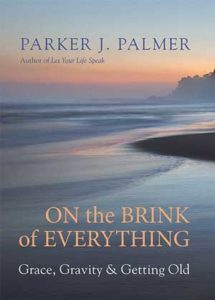On the Brink of Everything: Grace, Gravity, and Getting Old
Reviewed by Brent Bill
November 1, 2018
 By Parker J. Palmer. Berrett-Koehler Publishers, 2018. 192 pages. $19.95/hardcover; $9.99/eBook.
By Parker J. Palmer. Berrett-Koehler Publishers, 2018. 192 pages. $19.95/hardcover; $9.99/eBook.
Buy from QuakerBooks
I rarely read a book with a highlighter in hand. But soon after starting through this set of essays and poems by Parker Palmer, I went in search of one. This book is filled with nuggets of insight that I wanted to receive and return to again and again.
That’s because Palmer is a fine writer and a reliable witness. He is no “expert witness” like those in courtroom dramas, but rather faithfully relates wisdom gleaned from success and failures along the pilgrim path.
“Every day, I get closer to the brink of everything.” That’s how Palmer opens. Immediately, I thought, “Tell me more,” because that’s a feeling I’ve been having and learning to embrace of late. He proceeds to do so. On that same page he says, “I’m done with big and complex projects, but more aware of the loveliness of simple things: a talk with a friend, a walk in the woods, sunsets and sunrises, a night of good sleep.” While I agree with the loveliness of the latter, I would argue with him that he is not quite done with big and complex projects (after all, putting together a book dealing with the topics he addresses here is a big and complex project!), but rather he has learned the value of doing what is truly important. And part of learning what is truly important depends on where we are in life and our vocation (which he addresses in a later chapter).
The second and fifth chapters work especially well together. Chapter two is subtitled “The Dance of the Generations,” and chapter five is about staying engaged in the world as we age. As Palmer notes in the opening of chapter two, throughout his life he’s been lucky to have worked with people younger than he was. This chapter illustrates the joy of intergenerational relationships and learning. Chapter five reminds us that while the energy and enthusiasm of youth will invariably change as we grow old, we aren’t dead yet and have important work and wisdom to impart—not, as Palmer notes, so that we can warn from making the mistakes we made, but to “share our experience with younger folks in ways that help them step up, not back . . . let’s walk alongside them as they ‘do it anyway.'” In chapter five, Palmer also urges us to dismiss the idea that advancing age is the time for withdrawing from serious engagement in the world—especially in perilous times such as these. I’m thankful for Palmer’s call to avoid that trap of thinking my work now is nothing compared to my work earlier in my life. It’s not; it’s just different. And it’s work I couldn’t have done earlier.
The above is just one reason that the section on “Getting Real: From Illusion to Reality” is so important. Getting real helps us to move to our truest selves rather than living, in Thomas Merton’s words (quoted by Palmer), “lives of self-impersonation.” Palmer then relates the Hasidic tale of Rabbi Zusya who said, “In the world to come they will not ask me, ‘Why were you not Moses?’ They will ask me, ‘Why were you not Zusya?'” Getting real leads us, he says, to such authenticity and faithfulness rather than the world’s emphasis on results.
I also feel that chapters four (“Work and Vocation”) and six (“Keep Reaching In”) go together. Certainly it’s hard to determine one’s truest vocation without staying engaged with our souls. As Palmer says, “naming the jobs by which I’ve made a living is not the same as naming the vocation by which I’ve made meaning.” As we consider the work by which we make meaning, surely the most important practices for uncovering such meaning include silence, solitude, and soulful reflection.
The final full chapter is “Over the Edge: Where We Go When We Die.” Palmer offers some thoughts on this “ultimate tourist destination,” but largely concurs with singer-songwriter Iris DeMent’s statement: “I think I’ll just let the mystery be.”
While this volume addresses issues that may seem related mostly to those of us approaching what Palmer calls the “brink of everything,” it is not just for old adult Friends (or OAFs) like me. Adult readers of all ages will find On the Brink of Everything helpful and illuminating. Though as Palmer says, “there are no shortcuts to wholeness,” this is certainly a worthy guidebook for anyone walking that particular path.



Comments on Friendsjournal.org may be used in the Forum of the print magazine and may be edited for length and clarity.